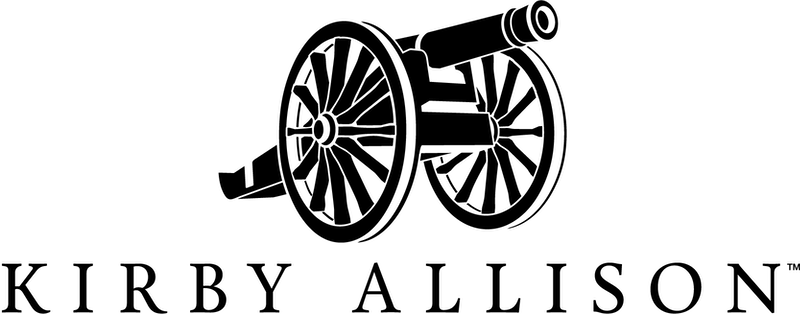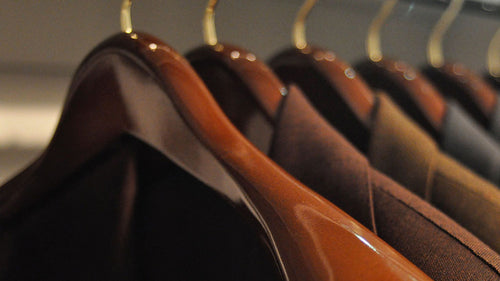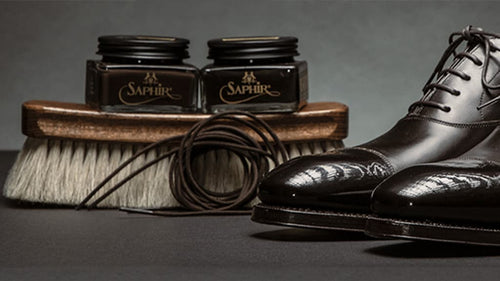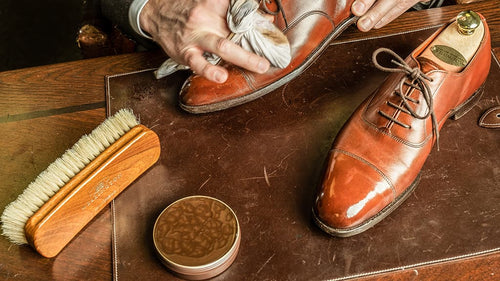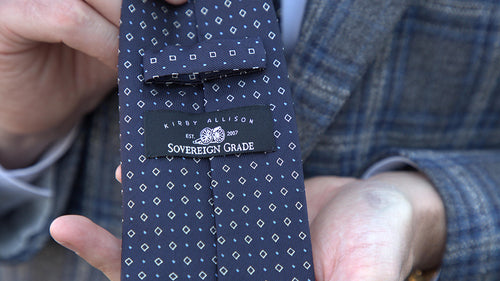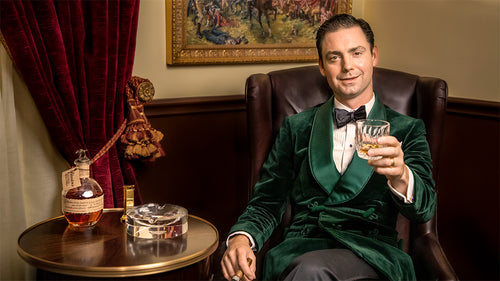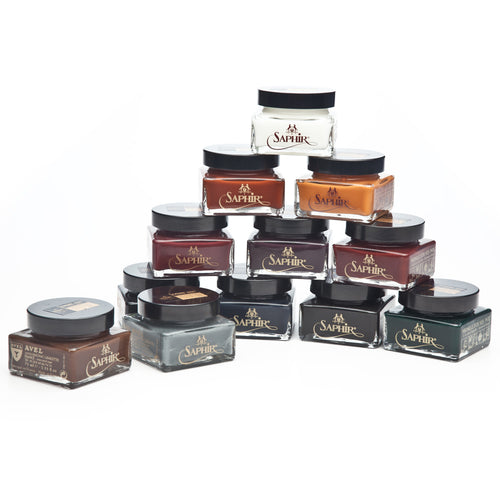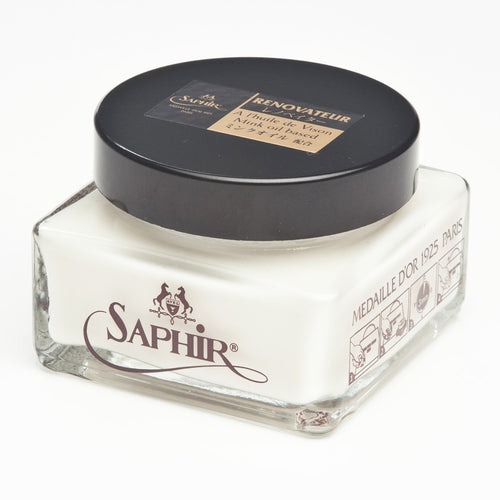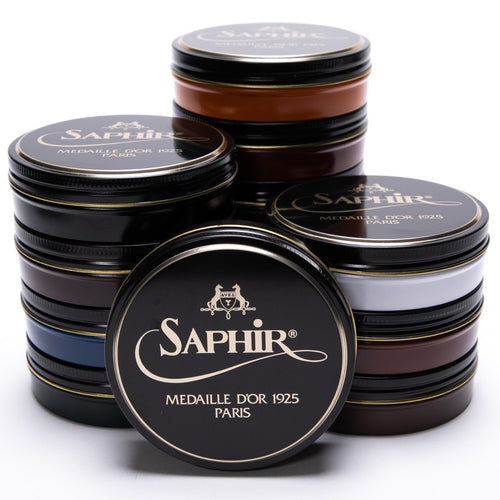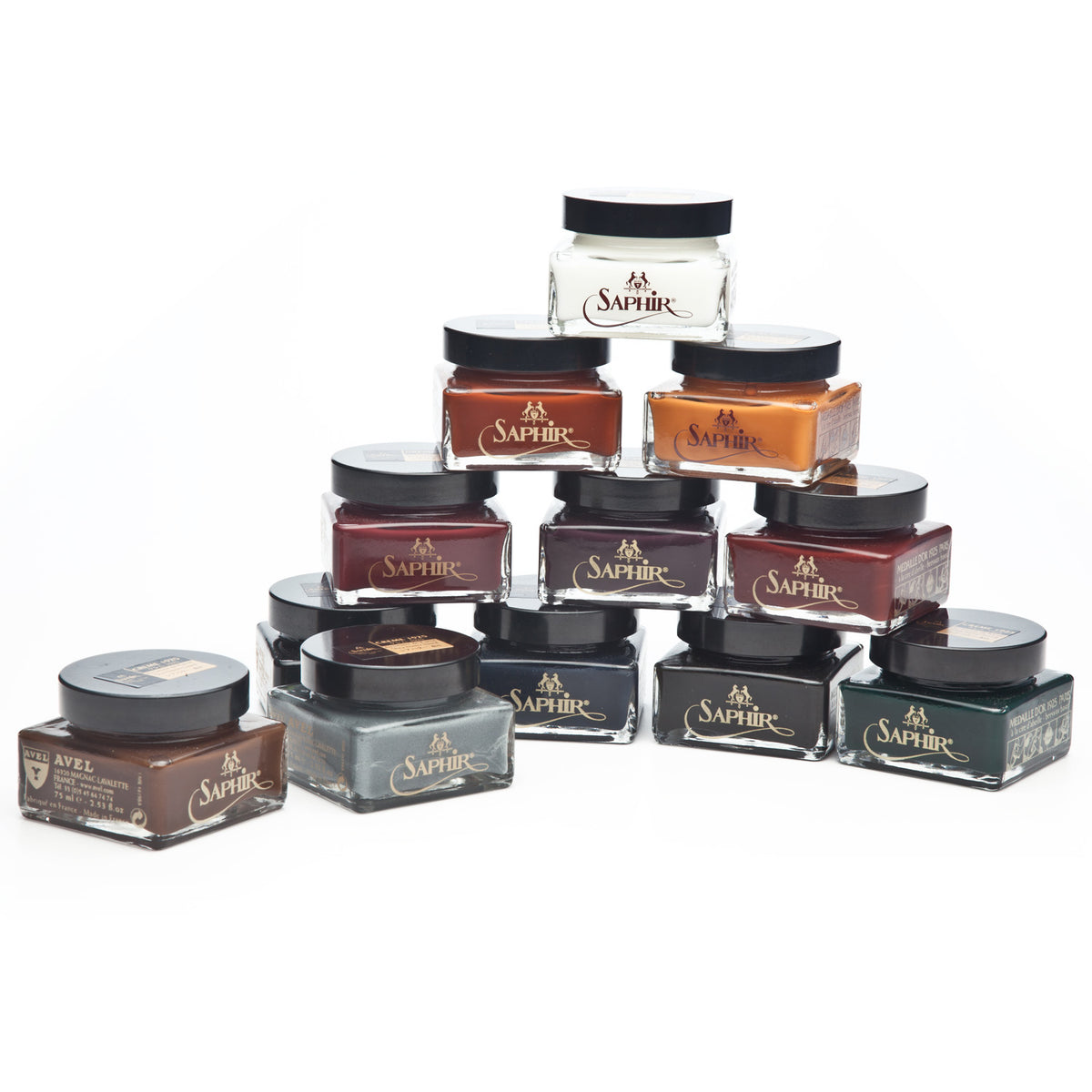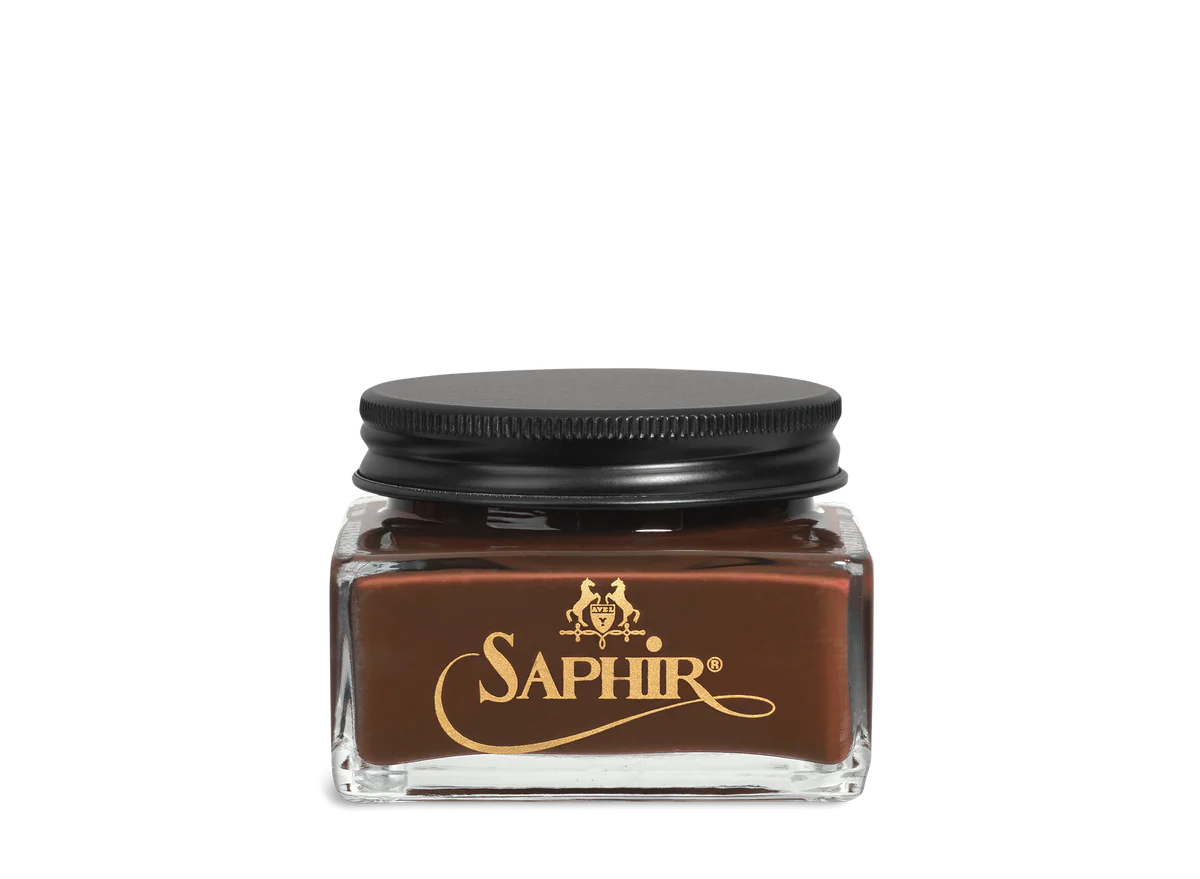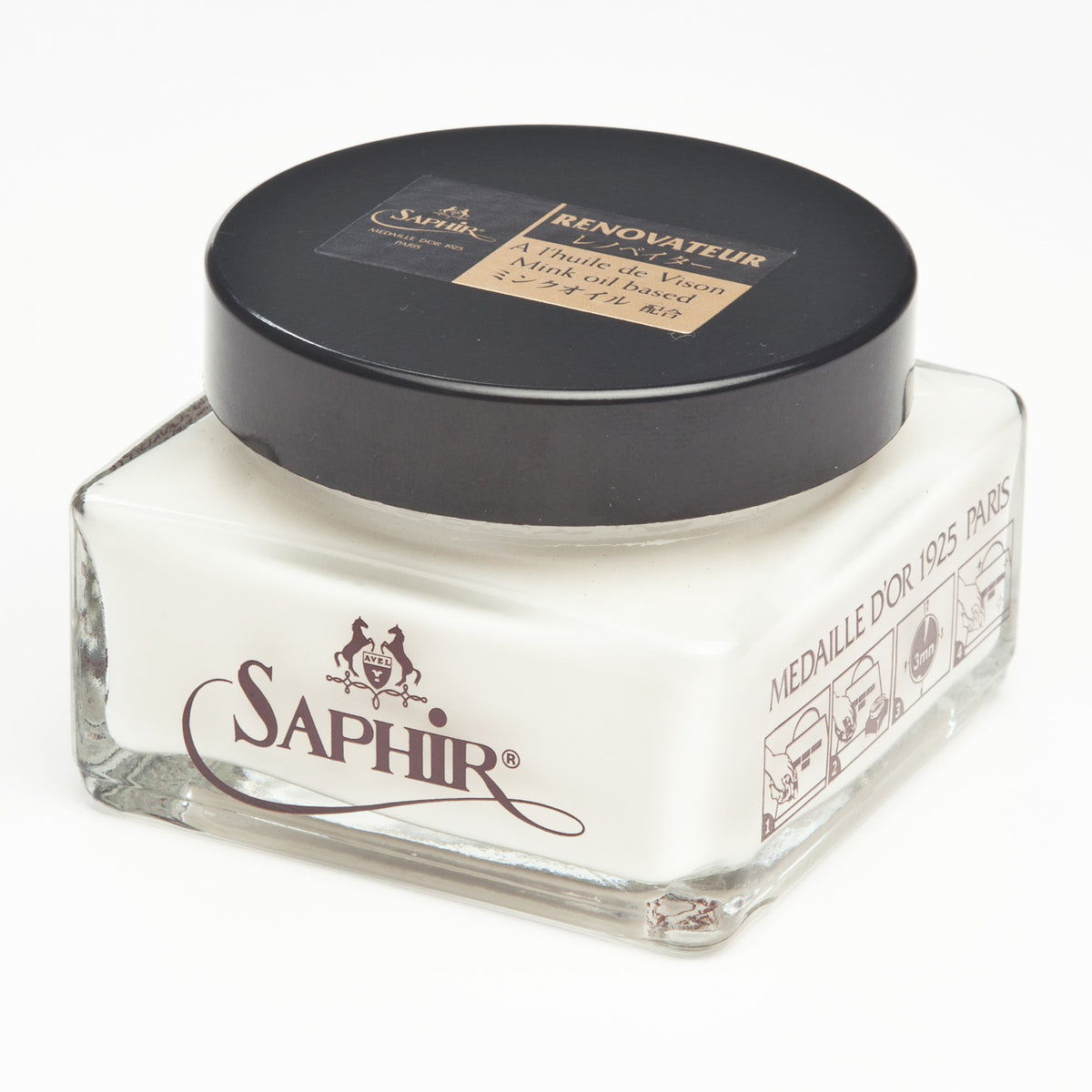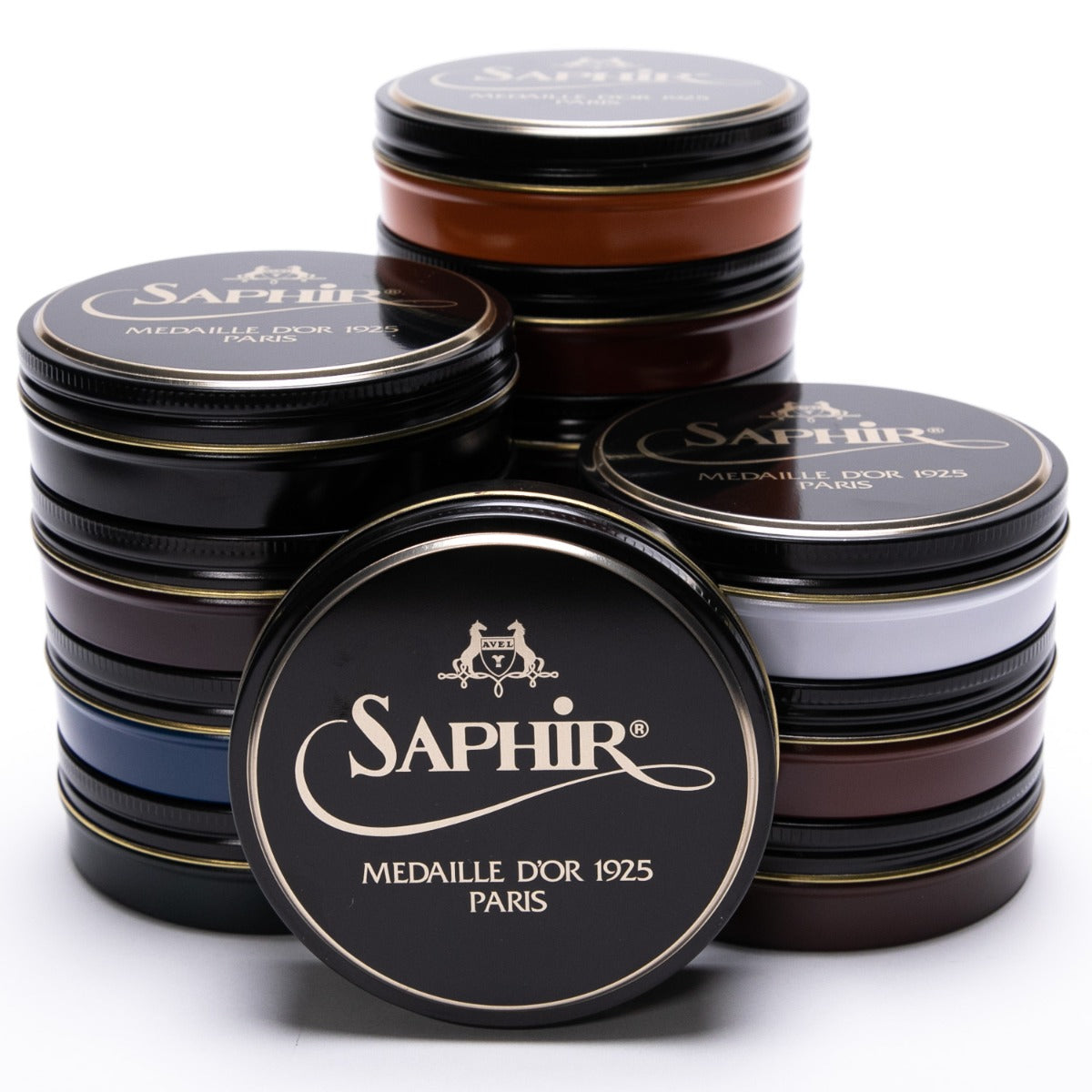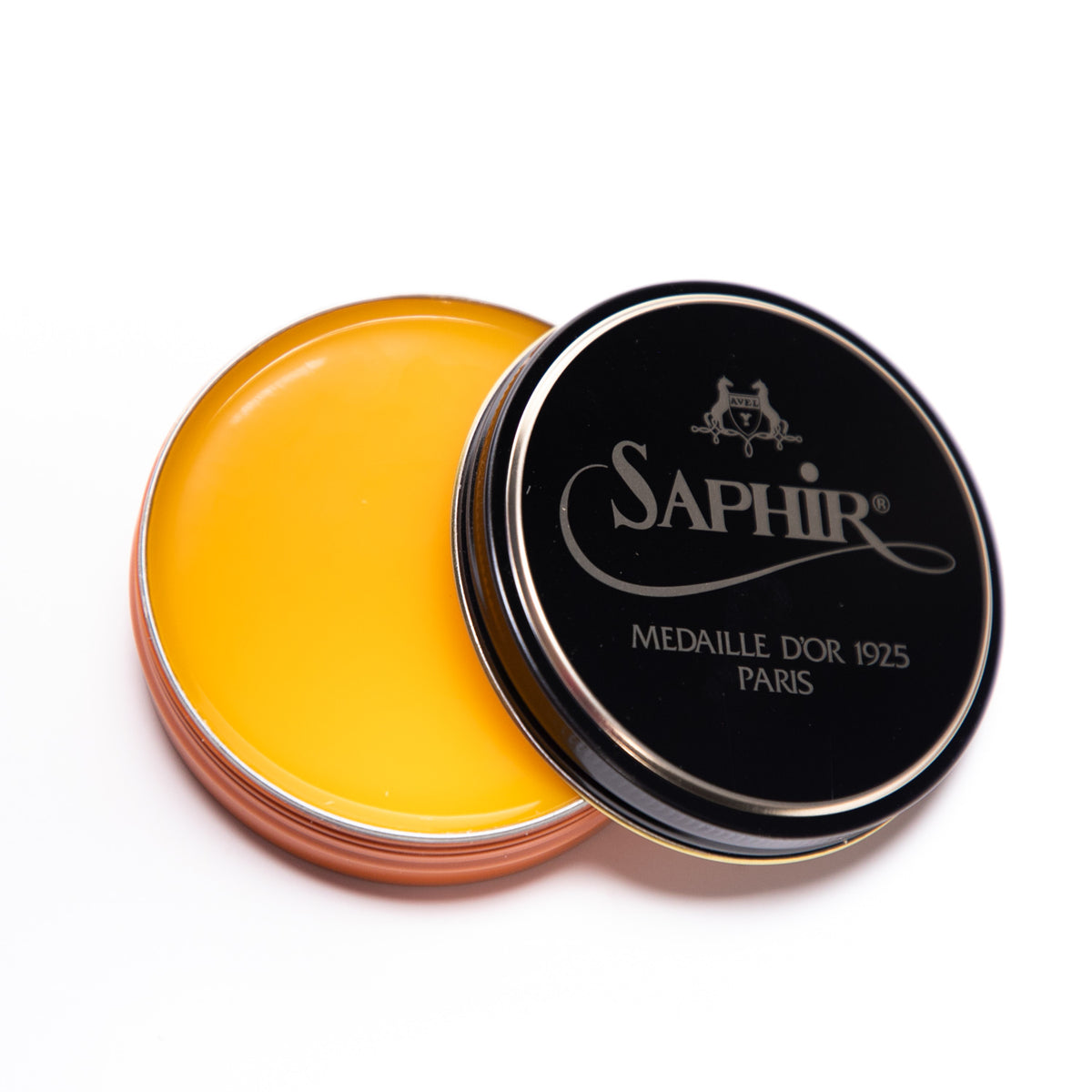Lee Miller, the iconic custom bootmaker from Texas Traditions, measures Kirby Allisons shoe for a boot last
Transcription
Hi I'm Kirby Allison founder of The Hanger Project and here at The Hanger Project we love to help the well-dressed take care of their wardrobes. Earlier this year I had an opportunity to go down to Austin, Texas and visit with Lee Miller from Texas Traditions. He's easily one of the most renowned preeminent custom bootmakers around these days and he is a legend in his own right here in Texas. I had an opportunity to visit him to commission my first pair of custom boots through Lee Miller and the first part of that process was going down and having him take detailed measurements of my feet. You know, based in a small humble workshop off of South Congress Avenue in Austin, Texas, Lee Miller is not just making boots for country music legends and Texas oilmen but also for ordinary people like you and me. Lee Miller is an absolute pleasure to work with and one of the things that really struck me is his humility and commitment to the craft and speaking with Lee he is as passionate about boot making and about craftsmanship today as he probably was when ever he began his career. And it's one of the things that I've really appreciated about him was his humility his genuineness and just his true commitment to craftsmanship and so and going down and having my measurements taken it absolutely blew me away because it was one of the most thorough and detailed processes of having my measurements taken that I've ever experienced.
And so in this video we're going to show you the full process of lead taking measurements and he actually walk you through each step kind of explaining why and what he's doing so that you can better understand them. And so this is quite a long video I believe it's almost 45 minutes. But we didn't want to cut anything from the process. We really wanted to have the entire process available to you through this video so that you could see everything that he's doing and really understand the purpose of his measurements and his process. So enjoy this video if you have any questions about this process. Feel free to ask them in the comments section below. I'll try to get back to all those questions personally. And lastly I hope you're able to enjoy this process as much as I did.
Lee, nice to see you. Thanks for coming.
Oh sure. Thank you for coming into the show.
You know it's so exciting to finally be back. You know I've been I guess looking forward to finally getting a pair of boots started for years it seems like.
Well we'll do a good job for you.
So the first step is going to be taking measurements, right.
Yeah absolutely. So that's the beginning of making a pair of boots is just measurement for you. So I'm gonna spend some time with you. We'll go through the process and then after that it's just setting up the last and taking it from there.
Okay so great anyway so go ahead and remove your shoes and then the socks you're wearing today, Kirby, are those the socks that you might wear with your boots? Yes it's a pair of dress socks, is that- do people wear different socks with their boots? I don't I don't know what .
It's all personal preference. Some customers like a thin sock. So I wear a heavy sock. But it's all it just all comes down to what you like. Yeah the thicker the sock obviously the more padding really. OK. So. Do you have any do you own any boots, Kirby? You know, I don't own any boots. This is my first pair. I do have a bunch of dress shoes of course.
OK. So this will be your first pair. Wow. OK.
It's a privilege.
Do you have any issues with getting anything to fit?
You know the biggest issue I have with is that kind of a high instep right here. OK. And so. I've got a bump on top of my foot that you know anything produces discomfort around my shoe that's it.
Yeah OK. Other than that it's ok?
But other than that I. Have a pretty straight.
If you were to buy something just off the shelf what would you wear in terms of size?
Like a 9.
A 9. And what about width.
A standard D.
OK so a 9D shoe. And what I'm going to do is I'm going to write down the comments you make so that I know to pay attention to that. So for instance you feel like you have a high instep and you can't you'll sometimes get pressure on them.
Especially towards the end of the day.
Sure.
So yes as I work on your order Kirby the things that you tell me I'm going to be focusing on and I'll make some notes too as to what I see what I'm looking at when I look at your foot Kirby is just trying to determine the characteristics of your foot.
So you have a high arch a high arch and a high end step your foot your foot is fairly thin.
And so that means that anything that's tight is going to hurt you. OK. And so because there's not much padding on your foot like somebody had a very fleshy foot and then you could squeeze and the customer wouldn't feel wouldn't really feel it probably would even like it. A lot of times when you shake someone's hand basically you're shaking there you're touching their foot because the hand and the foot are similar in terms of how they're how your body is made. OK. So you have your handshake. If it's if it's a fleshy hand the foot will be similar. So when you're really when you're meeting somebody. I had a professor tell me that once.
And it's actually true. Now whenever you shake someone's hand you think of their foot.
Well you're supposed to if you have your act together.
Part of the fitting. Yeah.
And so for instance you have a high arch high instep and you have a straight heel.
OK.
So those are all things that I'm looking at. They go they go together as a package.
And so those are the kind of notes and I'm going to be making as a description of your foot.
So the high instep you would build it up.
The arch would be support in the insole.
Yeah. I mean.
What about that straight heel. I mean how does that change.
Well you just want to make sure that like for instance if something had too much cop in the back it would hurt you. OK. And so it's really it's just it's a description of what the last would look like. The last should have a high arch the last should have an instep that's similar to your foot and all of the stuff that I'm going to do is going to show me and these notes just kind of highlight it. Yeah. And I'm going to use a Brannock device and you're just going to remain seated. There you go.
OK.
And so you'll do a Brannock device and the Brannock device is going to give me a total length and then it's also going to give me the heel to ball. So total length you're actually really a 10. And then heel to ball which is what the critical part is that's for the fitting. Looks like you're a nine and a half.
So all that means is you have long toes and you're shorter this way. OK. And we'll do that on each flight.
And so where the shoes should flex. Is that is the.
Yeah you always whenever you fit you always fit the ball. So once again Kirby and in terms of length and the Brannock device is pretty accurate. It gives you a starting point.
So if you were to fit me in a pair of off the shelf boots, you'd fit in a 9 1/2?
9 1/2, yeah because that's that's what you are heel to ball.
I guess I'm a 9 UK.
And the first thing we're going to do is we are going to do. And we will do this foot first. Set your foot there. And. So I'm just going to have you stand up Kirby and just stand normally and try not to move, equal weight on each foot. So we'll do a side profile.
So this is all of this information that I'm taking this two dimensional information. It's all going to be used to create the last. So now we'll trace do a border outline of the foot and once again I'm using a tracing device.
Really kind of getting around those toes.
Yeah and I'm also pressing on the toes to make sure that they get full extension. And then we'll get the center of the big toe the center of the small toe. The fifth metatarsal and the beginning of the metatarsal which is here. And then over here the first joint. And then we'll do an inner wayfaring line.
And what's that?
That is really just where your foot is touching. The paper. And that was something that Charlie Dunn did. It really he didn't see a lot of bootmakers doing. So. Charlie didn't use an ink print. He used the pencil just to give him. I'll be using both. Now we'll get a total, total length.
So you kind of you reference those two and triangulate it together. Absolutely. It's all connected to the total length standing. And then go ahead and have a seat please and just leave your phone right where it is and then we'll use the contour gauge.
This is kind of interesting. This is something that I first saw in 1976 being used to measure John Wayne.
Really?
Yeah I graduated from school in 1976 and bought an Esquire magazine because it showed John Wayne being measured for cowboy boots. And there I saw the contour gauge being used for the first time. And this is really a very important tool. It's going to show me if I was to see what your foot looked like, at the straight ball, this is what your foot would look like. And so the last should replicate that.
So this little bit of information is critical. So there's your foot. And you can kind of see the shape. So this is how tall that joint is. This is how broad it is. So I'm going to make a copy of that.
I saw John Wayne having his foot measured that way. And then when I came to work for Charlie Dunn he was using it. OK. And so yeah. And so it's really it's great. It's an easy tool to get. I mean they sell this at any hardware store.
And again just about triangulating, so what points on a foot do you do that, do you do that at the straight ball?
So that's going from the first join to the fattest part of a little toe. OK so that's a straight ball. Yes so everything all is connected. And it all has to do with giving your giving you a good fit. So we'll do the same thing to the other foot.
And so the straight ball I guess, where the foot flexes I mean is affecting kind of the way the foot feels like it balances on the shoe the way that shoe feels like it balances on the foot?
Right.
Because I've had pairs of shoes before. I feel like the balance is off on one of the shoes because the flex point might be a little off.
Interesting. Well if we make the last match your foot then we're there. And that's the whole goal is to get the last to be the same as the foot. OK we're going to do the exact same thing here Kirby go ahead and stand up and stand with equal weight on each foot. So everybody who measures is going to do it a little bit different.
And they're all going to use just different things that they feel that they need to do the work that they're trying to do. So I'm doing this really just to get the information that I'm looking for in order to build the last.
How has your measurement techniques kind of changed or evolved over your career?
In the beginning you know of course you're starting from zero and you don't know anything and. And then in school you learn very basic information. Charlie Dunn was a big help to me in terms of getting me started. He was known as a fitter. And so he was doing things that I'd never seen anyone do before.
Like what?
Like the weight bearing line. The contour gauge, things like that. Paying attention to. I'm going to show you in a second, Kirby, something that you know is really important in terms of making a pair of cowboy boots. And you'll you'll see like some people will will measure the foot with a tape measure while while you're seated. And what we're going to do is we're going to measure your foot in the air. And so you'll get a different end result. A lot of people will do it with the foot resting on the on the table and then with the foot in the air you're getting in a sense a truer measurement.
And more reflective of what the last should actually be.
And that's a measurement of the foot not under load?
Yeah non weight bearing. So. So right now you're full weight bearing and most shoe makers and some bootmakers measure semi weight bearing. And I'm going to measure you so I'm taking tracings of your feet full weight bearing then the contour gauge is taking semi weight bearing and then all the girth measurements will be taken non-weight bearing. And so you get a you get a good picture of the foot that way. So go ahead and have a seat. Just leave your foot right where it is and we'll do the contour gauge again. So this is taken right at the straight ball.
How do you see people's feet evolving? So like I'm 34 you know I'm investing in a pair of boots. You know I hope to wear for three four decades.
Oh yeah.
How will my foot change? Will I at any point have to come and readjust making adjustments to the boot or.
As you grow older you know it is just a question of gravity.
Gravity.
And because your feet your whole body rests on your feet your feet will go through changes as you age with certain feet they'll grow longer with certain feet they'll grow wider and those are the kind of things that you can adapt to. I think I was initially an eight and a half as a young adult and now I'm down to 10. This is just basically a bridge. And so as the bridge collapses slightly, which it will, your foot will lengthen. But somebody with a very high arch will not see much in terms of lengthening they'll see more in terms of spreading.
Really?
So it really is foot type.
How much does having a pair of bespoke shoes, you know if you're always wearing bespoke, not always but wearing bespoke primarily bespoke shoes or bespoke boots. Do you find that the shape of the foot, because you have a more precise fit doesn't change as much if you're wearing ready to wear?
Exactly. You can take a healthy foot and you can destroy it by wearing something that doesn't fit.
And the foot will go through profound changes just to adapt to the space that you put it in. So yes if something fits you it's going to be supportive. There are people who believe that we should just be barefoot. But if this is a structure that does change with time it makes sense to go ahead and to wear something that will support it and not allow it to break down unnaturally. So you can take a healthy foot and create an unhealthy foot simply by wearing something that doesn't fit.
And what's worse then. If one is worse than the other shoe that's too large and there's too much room or a shoe that's too tight or, what are the worst characteristics of fit.
The common thought is that you always fit long and you fit narrow. And that would be the best in terms of preventative. If you fit short and wide that would be the best way to hurt your feet. OK. So really when in doubt go long and go narrow. So as long as you do that you'll get proper arch support. So go ahead and cross your legs so that one foot is over the other and your foot's in the air and just kind of bring it down. There you go. So you know we talked about some of the differences in you know in boot making and shoe making and and so this is one of the things is now your foot is non weight bearing. And so because of that I'm going to get the smallest possible measurement that I could get.
And the tape the function the tape is...
The function of the tape is just to mark points of reference and everything will be recorded. So this is the short heel. And of course how you pull the tape is critical. You just don't want to do anything to the tape. Just have a natural measurement. Which is what I'm trying to achieve. This is just a position point.
So that's the position point from which all other measurements are taken?
That's just the position point from where these measurements will be taken. It's a reference point for me. So what I'm going to start doing is I'm going to start measuring your foot Kirby as we descend and go towards the toe and I'm going to be making notes of any changes or how it changes.
And so as you're validating the measurements on the last you're checking this measurement you to do the same measurement on the last to make sure that they...
These are all reference points. And so I'm trying to go off of specific bones. As if you look at the tracing you'll notice that there are certain reference points marked and those are all bones. And so we're measuring really from. For the most part bone to bone.
And you've had your feet measured, Kirby, by a lot of different people?
Well I mean three.
Three, and have you noticed just - is that three counting me or three others?
Three shoemakers plus you.
OK. And have you noticed that those three shoe makers did it all differently?
You know, they all do it differently. I mean some take more measurements than others and then you know I think what's been fascinating for me was shoemaking is to see who is it that does an intermediate fitting and who doesn't. And then what's that intermediate fitting like so.
Right.
You know John Lobb London is straight to finish.
Is that right.
You know, I've never seen their measurements but they just claim to have the experience to be able to take it straight to fitting or straight to finish. Well you know Cleverley does an intermediate fitting, Foster's does an intermediate fitting, Dimitri Gomez in Paris has an actual trial shoe that he cuts open you know to actually see where the shoes fitting.
OK.
Or where the foot is fitting in the shoe.
This is the waist of the foot Kirby and the waist is that natural hollow. Yeah I've I've found that if I pay close attention to this part of it. And take lots of information and then if I pay pay close attention to the next step which is making the last I generally take two days to make the last. And so because I really slow it down and take careful measurements and then I carefully interpret it because of that, I generally get better end results. Eliminating the need for a trial fitting. You also want to make sure that the person who measures the foot is the person who makes the last. OK because there's all these slight little variances. And when you start interjecting other people in it then you get different interpretations. So it's really tough. You know so I measure your feet. I've set up last.
How soon after you do the measurements do you do the last.
I could I could I could do it three years from now. It wouldn't change anything.
OK.
The only thing that would change would be maybe your foot. But if you keep your weight stable then nothing should change.
So if you notice I'm making measurements, I'm making points on the tape as to where everything crosses over and the tape is going to get saved.
And so you put this tape on the last?
No the tape is just going to be measured but it won't be put on the last.
So I have one more point on the foot that I'm going to take which is the straight ball and if you remember I did the contour gauge of the straight ball so now I'm taking a girth measurement of that same point and both of these things are going to work together.
But that's the straight ball is more comfort of the toes, of the fore part. So there we go. This is done. The only thing we're lacking really is a leg measurement on this. So we're going to do the same thing now to the other foot. So seeing that done Kirby I mean did you did you notice things that I was doing that maybe other people...
Yes I don't so many people do the vertical measurement of the foot. OK. You know I've have never seen someone do the non-weight bearing measurements. It's always a weight bearing a semi,I've seen semi and full.
But never non?
Never non.
So what's interesting is and this is this is actually true. If I take your foot measurement here and I get nine inches and then I bring it down here I may get nine in three days. But normally shoemakers will go ahead and reduce that measurement to achieve their ultimate goal which unbelievably is non-weight bearing. So it's kind of like you're going in the back door to get to the front yard. This where we're just going to it.
And the other thing you see is a bunch of scribbling something like know "high instep" scribble it on the tracing.
If you notice I haven't done anything. No scribbles.
Yeah.
And that's because there's nothing to note. Everything and everything. Everything is just going. There's nothing glaring.
So if this was a tall joint I would make a note of that. If this was protruding greatly I would make a note of that.
So you would scribble?
Oh yeah absolutely. But in your particular case nothing has been nothing has been nothing is really sticking to that extent. That's a good way of putting it I guess. So once again we're going back to the straight heel. I'm sorry the, the short heel. Now the short heel is not used in really in shoe making. It's used not in this manner. It's used in a pull on boot.
So a pull on boot would be like a riding boot?
Riding boot, cowboy boots anything anything you pull on you don't lace generally has to do with heel height also. So this is 13 and an eighth. That's quite a bit different than the other one.
And so how is that important in terms of the construction so that so that it doesn't slip at the heel?
Yes that's actually true also too. We're going to be cutting paper patterns. And that short heel is used in certain aspects to get your foot in a pull on boot, we have we have dual problems. We've got to get your foot into the boot, and then once your foot into the boot the boot has to fit. So we have we have a problem of just getting you in. And so the short heel is going to come back and help us getting your foot in the boot. It'll come and then as I descend the instep that's when the measurements become relevant to the last.
OK.
So the short heel is really just to get you in and out of it.
OK.
If that makes any sense.
And that's something that you'd see maybe like an English shoemaker using for riding boots.
Exactly. And they would be measuring you different writing. Well they would be measuring you semi weight bearing and that would change everything. That would change all the measurements everything would expand.
And so how much, you know, whenever you're kind of studying you know you've studied a lot in terms of I guess developing your method. How much of it is taking inspiration from shoemakers taking inspirations from bootmakers makers or just completely developing your own technique or what Charlie taught you?
What you find out is crafts person artists anybody who makes anything that you really need to focus. You need to pay attention to what other people are doing to find hints of how you might be able to use that knowledge and then you basically take it back and you could call it woodshedding where you're using it you're trying to see what works what doesn't work and you throw out the things that don't help you. So really it's in the beginning in the early in the early years you're more you're being open to new methods and things like that. And then as you slowly develop your own style you slowly find out what works what doesn't work what's necessary what isn't necessary.
In the early days of measuring I might have taken an hour to measure someone's feet and they may have a plane to catch. Yeah. And so you've got to go ahead and you can't. You don't have the luxury of just spending time. So you really, so in the beginning you do pay attention to everybody and all the things that are out there every little nugget that you can find and then you slowly learn what is relevant and what isn't. And of course the ultimate goal is the same thing. You want to make sure you do a good job and that's what this is all heading towards. It is for us to do a good job for you.
Have you trained any other last makers?
I have trained a few. This this is really in my opinion the hardest part is to measuring the foot is not hard and it's taking that data and making a last. And I read a book that Ferragamo wrote called what was called Shoemaker Dreams. And in the book he talks about the secret that he developed fitting. And how to make a shoe that fits so beautifully but he never tells you in the book.
So when I read the book it was in 1986. Well number one I was angry because I was looking for the secret. And he didn't. He just he kind of tantalized you that it was there. But he didn't tell you what it was. But I've spent from 1986 till now finding the secret. And I did find it.
But you can't tell us.
Not at this point but but maybe what it is is that you know...
On your tombstone: "The secret is..."
Well no I, the people that work for me Kirby the people that work here they all are part of it and we show them you know all of the stuff that I've learned passing on to them.
And so the secret will be, they'll be shown. Yeah all of that stuff. It's not going to be on my tombstone.
Did Charlie share that with you?
I mean he Charlie was an amazing figure and yes he was very open about his techniques. And at any time I had a question he answered them. But I've learned a lot also on my own and so my techniques are a combination of all of the years of just me working as a bootmaker. You know I started in 1975.
Wow. You're going on 40 years.
I haven't done the math.
It's hard to do that. Incredible career though.
It's funny. I mean it's just really it just started out as something I wanted to do and it's become a passion.
I mean your Instagram page I love following because you know it's very clear, you know, you've got the passion. You know really someone that's just been keep getting out you know. Yeah.
I mean that that the fire and the intensity and the passion you can tell is still as strong today as you know it is for many people whenever they just begin something.
That's critical to keep that passion going because what happens is you keep learning you keep getting better you keep fighting you keep finding out little little nuances and that that's a continuous improvement.
What challenges you? I mean like what is it that you know kind of during your craft whenever you get a ride produces that kind of profound sense of satisfaction?
Well honestly Kirby it's when... I know that I can make a beautiful boot. But it's the fitting. That's the hard part. Making sure that your boots fit properly everything just kind of is right there.
It either does or it doesn't. So for me I know I can make a beautiful well-balanced boot.
But the fit is the critical part and so that's the challenge is to make sure they fit. And everybody's foot is different. Yeah. So it's a continuous challenge to make sure that I do it right.
So when's the moment when someone, I don't have your boots yet, right so I don't, it is, you know whenever a customer puts on their boot for the first time you can see their face?
I mean yeah I mean I'm literally looking at their feet.
Their feet. Yeah but you're feeling it like...?
Well I try not to be so obvious but I'm looking at their feet. And of course I want them to be happy with it, but it really is... Everything just comes down to that one moment. Where they try them on. And if there's any if you've done your if you've done your work right, the boots fit wonderfully and they're going to be supportive and almost magical in terms of how they make your feet feel.
And can you feel that or can you see it?
You can feel it and see it. Yeah. Now the last thing I'm going to measure on you, Kirby, is your leg.
OK.
I don't know how tall you want your boots to be but the standard height is 12 inches. Do you feel you want to - You know I like a taller boot. But it is a personal preference. Have you thought about that?
I haven't really thought of that.
OK. I can give you a boot to try on. You can just see if I mean it won't fit you but it'll be it'll be the right height and you want to do that? Or do you want me just to measure leg and you can see? Well pull your pant legs up. I mean so obviously a tall person might want a taller boot but it does come down just a personal preference. I like the way a tall boot looks.
Yeah I think I might prefer a taller boot.
OK so the standard boot is going to be, and you just remain seated, the standard boot is 12 inches tall and so 12 inches is going to hit you almost mid calf. So there's 12 inches so we could go up to 13 and that might be good.
I'd probably go 13. I mean I like the idea of a formal boot. You know, something that's a little dressier.
OK.
If it's too tall you might find that it's there's 13 and it hits you about mid-calf.
You want to settle there?
That looks good.
OK. So we're at 13.
How do you determine how much allowance that you give the top of the boot?
I mean basically I want to I want to give you a half an inch over your light measurement and you will have some customers that will say I want to tuck my pants in and so we have to allow for that. So the standard is a half an inch over the leg measurement.
OK.
And that would be to fit underneath a jean or a trouser.
I mean you will have some customers that say "listen you know my legs are really skinny. I always have problems with boots being extraordinarily loose. I want them tight fitting to my leg". So of course I'm going to do that.
But if you're doing a measurement plus half an inch and-
Yeah. So so pretty much it's just it's a half an inch over the leg measurement and that gives us a little bit of... So after I measure your leg the last thing I'm going to do is I'm going to go ahead and take an ink print of your feet and that will be used also in the last. Ok.
And the ink print is a reference point to the load or the load bearing trace.
The ink print is going to give me a border outline which is what I have already. And it's also going to give me a weight bearing part of the foot.
OK.
And from the ink print I can see the arch. I can see the structure of the foot. And that's going to help me do the bottom. So when I contour the bottom I'm relying on the ink print. I'm relying on this too, but the ink print gives me more depth. Nowadays most people have abandoned the ink print but you'll see shoemakers and bootmakers still using it.
Why would someone abandon the ink print?
Technology. Nowadays everything is in 3-D imaging and I mean as a bootmaker I need the clarity of the print. And I believe rubber was invented in 1836 and as far as I know the this came one year later.
Really.
Yeah. So all it is is a rubber bladder. Back then.
So bootmakers had been using this since the 19th century.
Absolutely and there's different forms in which it's done. But it's basically I mean ink to this side, put paper here you'll stand on it you'll push it. You've seen this before right, Kirby?
I have seen it here.
Have you ever had anyone do it? Never? Not all the shoe makers?
Never in all my life.
Oh that's interesting.
I don't even know of a shoemaker that uses them.
Really. Now you have the book Handmade Shoes for Men. OK. In that book they're using this.
So that's Laszlo Vass.
Vass.
Yeah. And so he's using it but really you're using it because you're looking for information. And this will give you the information you need. I'm using blue ink and blue ink will give you. It will be easier to read than if I was using black ink. Yeah. So it's primitive technology. So I'm going set your foot on it Kirby and then I'm just going to have you stand. There you go. Just stand with equal weight in each foot and just try not to move. So we'll do a border outline of the foot and I'm using a pencil, which is exactly what I used to trace your foot. And once again and pressing down on all the toes to get full extension. And then I'm going to mark the same reference points that I did on the tracing. So this will show me things that I can't see with the traditional tracing. All right go ahead and have a seat please and just lift your foot. There you go.
So there is a great reveal.
Wow!
So there we go. You'll notice how these two are very similar in terms of the inner weight bearing. So from this I'm going to go ahead and I'm going to find the metatarsals and that will give me the arch curve. And if I saw any if I saw any darkness that would be pressure and it would I would want to work to make sure that the bottom is sculpted to relieve the pressure. So I mean obviously there's darkness here darkness there. Normally it's the foots like a tripod. And so you got one two three. And I can see there is the fifth metatarsal there. So when I get ready to use I'm going to find all the metatarsals and I'll do a centerline of the foot. And you've seen it on my Instagram right? So but you can see things here that you cannot see here.
Yeah.
And so for me I need that because I'm trying to do a good job for you.
So whenever you're building in the insole you'll use that to kind of absolutely kind of sculpt.
Absolutely.
What is it called. Dig it out or...
We'll go ahead and match the bottom of the last to the bottom of your foot. And we'll be using primarily this, the information I gather from this.
We had a young man who was here in 1991 from Munich, Germany and he went through the German shoe making program. And so he came here to learn to make cowboy boots and so we had to do a curriculum with the German government.
They were dictating they wanted to know what he was going to be taught. This was a two and a half year program we did with him. And they even told us how much we had to pay him.
Oh really?
But anyway this guy was amazing. Of all the people that we've had here, he was the best.
And where is he now? He lives here.
In Austin?
Yes.
Is he doing boots? No no he said it was.
Too difficult?
Too difficult. You nailed it Kirby. I mean he was the best. I'm going to do the same thing to your other foot. But I learned a lot from him, Kirby.
What about the, I mean, you've had people come in from all over the world. Do you see a difference in like the Japanese versus the British versus...?
Oh yeah absolutely. The Japanese are amazing. I mean I've seen their work and it's just it's hard to believe that a human being can achieve such levels of perfection. So they're devoted to perfection. They're devoted to the whatever they do they just seem to do it to a higher level. And that's that's very nice to see. It makes you feel good as a craftsman to see somebody poor their whole being into it.
Do you find them and you think that someone can become too clinical about a craft?
Yeah you absolutely can be to come become too clinical. But if if you're like, we're in business, Kirby, and so you you can't become so clinical that you just drive yourself out of business. So it's all rooted in practicality. And as long as we're rooted in practicality it actually helps us. To not go too extreme. Go ahead and have a seat and just lift your foot. There you go.
So you put it right here and then that's....
Yeah. So I'm basically looking at this. And you can see the. You can see the correlation between the tracing that was done to the pencil and the use of the ink print. But the print gives you more depth. That's the way I would be using it. Yeah just like that.
I want a center line.
OK.
OK and the center line will be you know I'm going to measure across the heel to get a center point and I'm going to go ahead and I'm going to do all the five metatarsals and I'll get a nice I'll get some type of an arch curve and then I'll connect one to the other and I'll be able to see it and that'll show me how the foot moves and it'll show me you know how to support you. So I'm looking for I'm looking for the there's the fifth metatarsal. There's the First metatarsal.
And you can see that.
I can see it. Yeah and then I'm looking for the others that are in the middle. And so I can find the center of your toe, and travel back to where the metatarsal is and that can give me an idea of the shape of the bottom of your foot.
So it's not an X-ray. You know, Kirby, that at one point they were using x rays in footwear. You've heard that story?
I haven't.
And if you if you meet somebody who's old enough they remember running into the shoe store as a kid and putting their hand in the x ray machine to see the bones.
And we've had customers tell us that. So you know they were using it so that you could go ahead and X-ray the foot in the shoe and make sure it fit. Much like today you say they cut open the shoe and peer into it. So of course it's unhealthy. But those are the things I'm looking for, Kirby. I'm looking for the metatarsals, looking for any undue pressure.
And that's just helping the shoe be comfortable because again, the fit and the balance of the last. And this is something you cannot get in an off the rack shoe. It will be missing because the last is the key. And like the shoes you wore in today are beautiful. So the last is the key. Here's the last. And so I want the last to basically represent the foot. And then we'll add the toe shape after. And of course I'm going to do things to will last. I'm not basically taking a mold of your foot I'm using it as is. I'm going to go ahead and sculpt it. So it will be it'll be a facsimile of your foot but it won't be your foot.
OK.
But but you'll never get that in something off the rack.
Yeah.
And my point is this. Everything that's made that you can just go in and buy off the shelf, it all started with the last. Well, the person who made the last, if they didn't know their trade ,they would make a bad last and then that would produce a bad shoe and it would hurt the wearer.
And they have to produce a last that is general enough that it can fit 85 percent of all feet.
That's right. But so there are so many points of reference on the bottom in the whole last long unless they are expert fitters they're not going to do a good job. So the lastmaker relies on the seller to tell them if it's a good fitter. And honestly the seller doesn't know. So you have a blind and a blind. So as the maker we can measure your foot we can sculp the last to fit you. And that's the difference between bespoke and off the rack is that it's the knowledge of the maker in the last.
And so even there within bespoke you have a continuum because there's a ton of custom boot guys. You know but it's like custom shirts. And what does that mean?
It's all about focus and it's what you focus on. So like getting back to what I said. I know that we can make a beautiful boot. That part is relatively easy. Yeah this is the hard part. And so if I focus if my energies are focused on the hard part.
I'll have a better end result. So the last thing I need from you Kirby, is your signature and all that means is you were here.
That's great.
So this is, there you go, if you'll just give me your autograph. Right there. And we're all done.
What's the day, September 21st? 22nd? September 22nd 2017. That's exciting.
OK thank you Kirby, so we're done with the fitting.
Hey Lee, thank you so much.
You can step on down now.
There we are. So as you can see, you know, Lee has taken detailed measurements and one of the questions I asked Lee is that how soon after taking these measurements. You know do you really need to sit down and work on creating the last and Lee said you know with the detailed measurements and the precision and the thoroughness with which he does that he could take those measurements out of his cabinet a year or two years from now and still make a last that's going to fit perfectly. And Lee being particularly well known as such a great fitter, you can see that that the detail and the precision of his measurements really do translate into a better quality last. So that was the first step, next step in this process is to work with his wife Carolyn to really determine what the boot design is going to look like so I'm going to do that next. I'm Kirby Allison founder of The Hanger Project and here at The Hanger Project, we love helping the well-dressed take care of their wardrobes. Please take a moment to visit HangerProject.com where you can view the most comprehensive and cohesive collection of luxury garment care and shoe care products in the world as well as other accessories for the well-dressed. I'm Kirby Allison, founder of The Hanger Project, and thanks for joining us.

